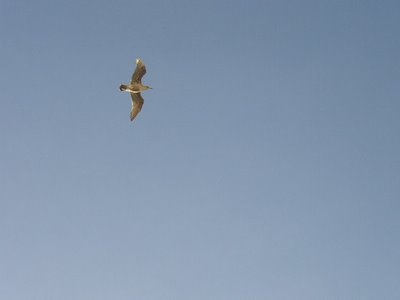| Canadian polar bears are getting thinner and hungrier, even as environmentalists fear the magnificent beast of the north may become extinct in this century. The reason: global warming. In search of food, the animals roam through the garbage dumps and gardens of the northern Canadian town of Churchill. Signs along the streets warn people about the bears. Polar bears have prowled into living rooms of homes devouring packages of dog food and other items, and there's a 24-hour polar bear emergency telephone line to summon help. The Polar Bear Police sedate the intruder with a narcotic-filled dart, then take it to one of the 24 cells of Churchill's polar bear jail, where it remains until it can be released in winter to the ice-covered Hudson Bay. However, the jail is frequently full. In that case the polar bear must be transported by helicopter farther north. This is far from an ideal solution, because polar bears have difficulty settling into a new area. The dens where females give birth to their babies often are used over generations. Some residents of the northern Canadian town of Churchill sleep with a pistol under their pillow. Others never go out unless they are armed. Children are taken to school under guard and can't play outside during certain times of year. Churchill lies on the edge of the Arctic tundra, where there are two polar bears for every human resident. And the 500-to-600 kg bears are getting hungrier all the time as a result of a chain of events blamed on global warming. Polar bears' chief food is seals, but their only chance to catch them is when the animals come up for air through holes in the Arctic ice. In open water the seals are far too fast for the bears. Over the winter, when seals are more easily caught, the polar bears' weight increases by as much as five times. But when the gigantic Hudson Bay thaws, they go hungry. In a critical situation they can go as long as eight months without food, but the length of their fast is growing longer year-to-year. Higher temperatures have caused the bay to freeze later in the year and thaw earlier. In the last 20 years the length of time the bay is frozen has shortened by three weeks. "The trend for earlier break-up is really important for polar bears, because the spring is when polar bears store most of their energy," Ian Stirling, a research biologist for the Canadian Wildlife Service, told The New York Times. One forecast shows the loss of ice in the Hudson Bay, and Stirling said if that happens, the polar bears may be lost. Polar bears suffer in another way. Drowning has become more common because the bears wander onto thin ice and fall through. When the ice breaks, the polar bears find themselves too far from land to swim to safety. Canadian researchers have determined that polar bears weigh an average of 10 percent less than 20 years ago, and are producing fewer offspring. Based on Stirling's calculations, the number of polar bears on the west coast of the Hudson Bay has declined 22 percent between 1987 and 2004. Canada is home to the largest number of polar bears, estimated at about 15,000 by the Churchill Northern Studies Centre. Total world population is about 22,000, the WWF says. The species is not listed as endangered, but hunting is restricted under agreement by Canada, the US, Denmark, Norway and the former U.S.S.R. In Churchill people tend to take the problem in stride because polar bear tourism is the community's main source of income. But there is concern among environmentalists that polar bears could go extinct in the current century. Catarina Cardoso, a climate expert for the World Wildlife Fund, said they could become something that in a few generations will exist only in a book and in pictures and movies. Their plight also symbolises the "disappearing north", Peter Tabuns, executive director of Greenpeace Canada, told the Times. --DPA am/(IANS) | 






























